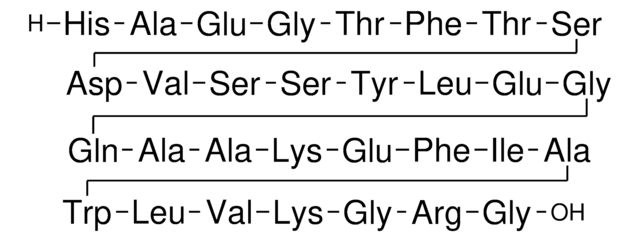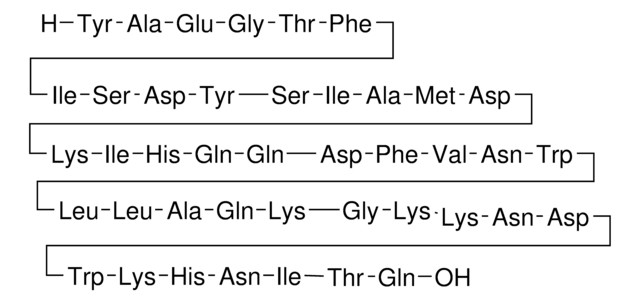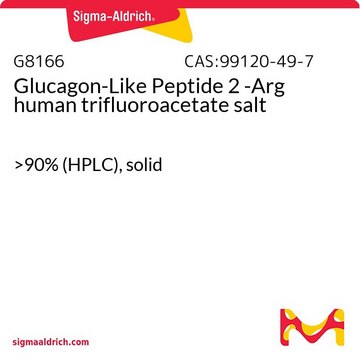G8147
Glucagon-Like Peptide I Amide Fragment 7-36 human
≥97% (HPLC), powder
Sinónimos:
Preproglucagon 78-107 Amide
About This Item
Productos recomendados
Quality Level
assay
≥97% (HPLC)
form
powder
UniProt accession no.
storage temp.
−20°C
SMILES string
CC[C@H](C)[C@H](NC(=O)[C@H](Cc1ccccc1)NC(=O)[C@H](CCC(O)=O)NC(=O)[C@H](CCCCN)NC(=O)[C@H](C)NC(=O)[C@H](C)NC(=O)[C@H](CCC(N)=O)NC(=O)CNC(=O)[C@H](CCC(O)=O)NC(=O)[C@H](CC(C)C)NC(=O)[C@H](Cc2ccc(O)cc2)NC(=O)[C@H](CO)NC(=O)[C@H](CO)NC(=O)[C@@H](NC(=O)[C@H](CC(O)=O)NC(=O)[C@H](CO)NC(=O)[C@@H](NC(=O)[C@H](Cc3ccccc3)NC(=O)[C@@H](NC(=O)CNC(=O)[C@H](CCC(O)=O)NC(=O)[C@H](C)NC(=O)[C@@H](N)Cc4c[nH]cn4)[C@@H](C)O)[C@@H](C)O)C(C)C)C(=O)N[C@@H](C)C(=O)N[C@@H](Cc5c[nH]c6ccccc56)C(=O)N[C@@H](CC(C)C)C(=O)N[C@@H](C(C)C)C(=O)N[C@@H](CCCCN)C(=O)NCC(=O)N[C@@H](CCCNC(N)=N)C(N)=O
InChI
1S/C149H226N40O45/c1-17-76(10)119(146(232)167-80(14)126(212)175-104(60-86-63-159-91-36-25-24-35-89(86)91)136(222)177-100(56-73(4)5)137(223)186-117(74(6)7)144(230)174-93(37-26-28-52-150)128(214)160-65-110(197)168-92(122(154)208)39-30-54-158-149(155)156)188-138(224)102(57-83-31-20-18-21-32-83)178-133(219)98(47-51-115(204)205)173-132(218)94(38-27-29-53-151)170-124(210)78(12)164-123(209)77(11)166-131(217)97(44-48-109(153)196)169-111(198)66-161-130(216)96(46-50-114(202)203)172-134(220)99(55-72(2)3)176-135(221)101(59-85-40-42-88(195)43-41-85)179-141(227)106(68-190)182-143(229)108(70-192)183-145(231)118(75(8)9)187-140(226)105(62-116(206)207)180-142(228)107(69-191)184-148(234)121(82(16)194)189-139(225)103(58-84-33-22-19-23-34-84)181-147(233)120(81(15)193)185-112(199)67-162-129(215)95(45-49-113(200)201)171-125(211)79(13)165-127(213)90(152)61-87-64-157-71-163-87/h18-25,31-36,40-43,63-64,71-82,90,92-108,117-121,159,190-195H,17,26-30,37-39,44-62,65-70,150-152H2,1-16H3,(H2,153,196)(H2,154,208)(H,157,163)(H,160,214)(H,161,216)(H,162,215)(H,164,209)(H,165,213)(H,166,217)(H,167,232)(H,168,197)(H,169,198)(H,170,210)(H,171,211)(H,172,220)(H,173,218)(H,174,230)(H,175,212)(H,176,221)(H,177,222)(H,178,219)(H,179,227)(H,180,228)(H,181,233)(H,182,229)(H,183,231)(H,184,234)(H,185,199)(H,186,223)(H,187,226)(H,188,224)(H,189,225)(H,200,201)(H,202,203)(H,204,205)(H,206,207)(H4,155,156,158)/t76-,77-,78-,79-,80-,81+,82+,90-,92-,93-,94-,95-,96-,97-,98-,99-,100-,101-,102-,103-,104-,105-,106-,107-,108-,117-,118-,119-,120-,121-/m0/s1
InChI key
DTHNMHAUYICORS-KTKZVXAJSA-N
Gene Information
human ... GCG(2641)
¿Está buscando productos similares? Visita Guía de comparación de productos
Amino Acid Sequence
General description
Application
- in lysate transfer cyclic adenosine monophosphate (cAMP) assay to test its effect on adenylyl cyclase activity
- to pre-treat the human umbilical vein endothelial cells (HUVECs) to monitor its effect on hyperpermeability in endothelial cell (EC) monolayers and changes with the actin cytoskeleton
- to test its inhibitory effect on vascular endothelial growth factor-A (VEGFA) based vasodilation in rat mesenteric arteries
Biochem/physiol Actions
Other Notes
Storage Class
11 - Combustible Solids
wgk_germany
WGK 3
flash_point_f
Not applicable
flash_point_c
Not applicable
ppe
Eyeshields, Gloves, type N95 (US)
Elija entre una de las versiones más recientes:
¿Ya tiene este producto?
Encuentre la documentación para los productos que ha comprado recientemente en la Biblioteca de documentos.
Los clientes también vieron
Nuestro equipo de científicos tiene experiencia en todas las áreas de investigación: Ciencias de la vida, Ciencia de los materiales, Síntesis química, Cromatografía, Analítica y muchas otras.
Póngase en contacto con el Servicio técnico








![(Tyr[SO3H]27)Cholecystokinin fragment 26-33 Amide ≥97% (HPLC), powder](/deepweb/assets/sigmaaldrich/product/structures/125/021/32eb71ec-73e5-4cfc-94d0-ebcf5e784e39/640/32eb71ec-73e5-4cfc-94d0-ebcf5e784e39.png)

